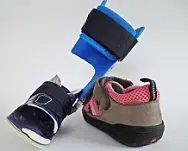In order to know the meaning of the term orthosis, it is necessary, first of all, to discover its etymological origin. In this case, we have to state that it is a word that derives from Greek, since it is the result of the sum of the following lexical components of said language:
-The word "orthos", which can be translated as "right."
-The verbal form "tithemi", which is equivalent to "I put."
-The suffix "-sis", which is used to indicate "action."
The term orthosis is not part of the dictionary of the Royal Spanish Academy ( RAE ). However, this notion, which is also mentioned as an orthosis (with an accent on the O ), is used in the field of medicine to refer to the external device that is applied to the body with the aim of modifying the structure or functioning of the muscular system. -skeletal .
 An orthosis, therefore, can be a splint , a support or another device that contributes to the development of an action or that corrects it. In this way, it achieves an improvement in the functioning of the musculoskeletal system or corrects a deformity.
An orthosis, therefore, can be a splint , a support or another device that contributes to the development of an action or that corrects it. In this way, it achieves an improvement in the functioning of the musculoskeletal system or corrects a deformity.
Physiotherapy , podiatry and orthopedics , among other medical specialties, use orthoses in the treatment and rehabilitation of their patients. At a general level, they provide security in movements, save energy and minimize pain.
It is important not to confuse an orthosis with a prosthesis . While orthoses are external supports, prostheses are responsible for replacing - whether partially or totally - a limb or an organ with a dismetria, disability or disability.
A doctor must be in charge of prescribing an orthosis after analyzing the patient's body. This professional has to indicate which is the appropriate product according to the defect detected. There are protective orthoses , stabilizing orthoses , corrective orthoses and functional orthoses .
Protective orthoses, on the one hand, what they do is properly align a member of the body that is injured or unload that member.
On the other hand, stabilizing orthoses have the main function of controlling a limb or a segment thereof by stabilizing its corresponding joints.
Corrective orthoses, for their part, are responsible for, as their name indicates, correcting what is a deformity.
Finally, we can establish that the aforementioned functional orthoses perform a specific function on a member of the body that is paretic or paralyzed in a certain segment. Precisely to achieve this objective they have an element that can be elastic or contractile. We are referring to the fact that they can have a spring, an electrical device...
However, there are other classifications of so-called orthoses. Thus, for example, we also talk about upper limb orthoses, lower limb orthoses or even so-called spinal orthoses, among others.
Just as there are orthoses that correct movements or postures, others stabilize a region. Orthoses can either mobilize an area of the body in a controlled manner or completely immobilize it, depending on what is necessary.
